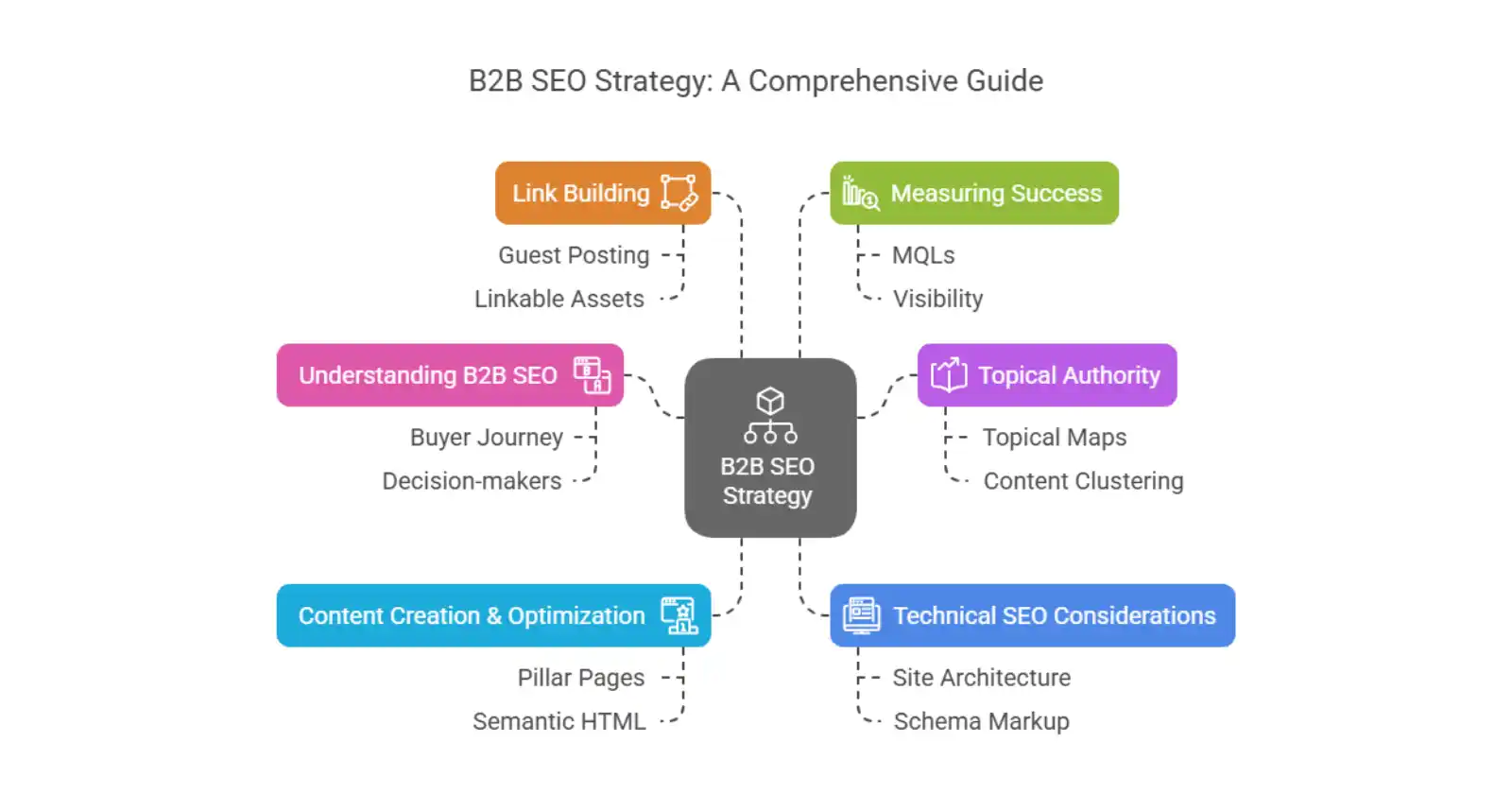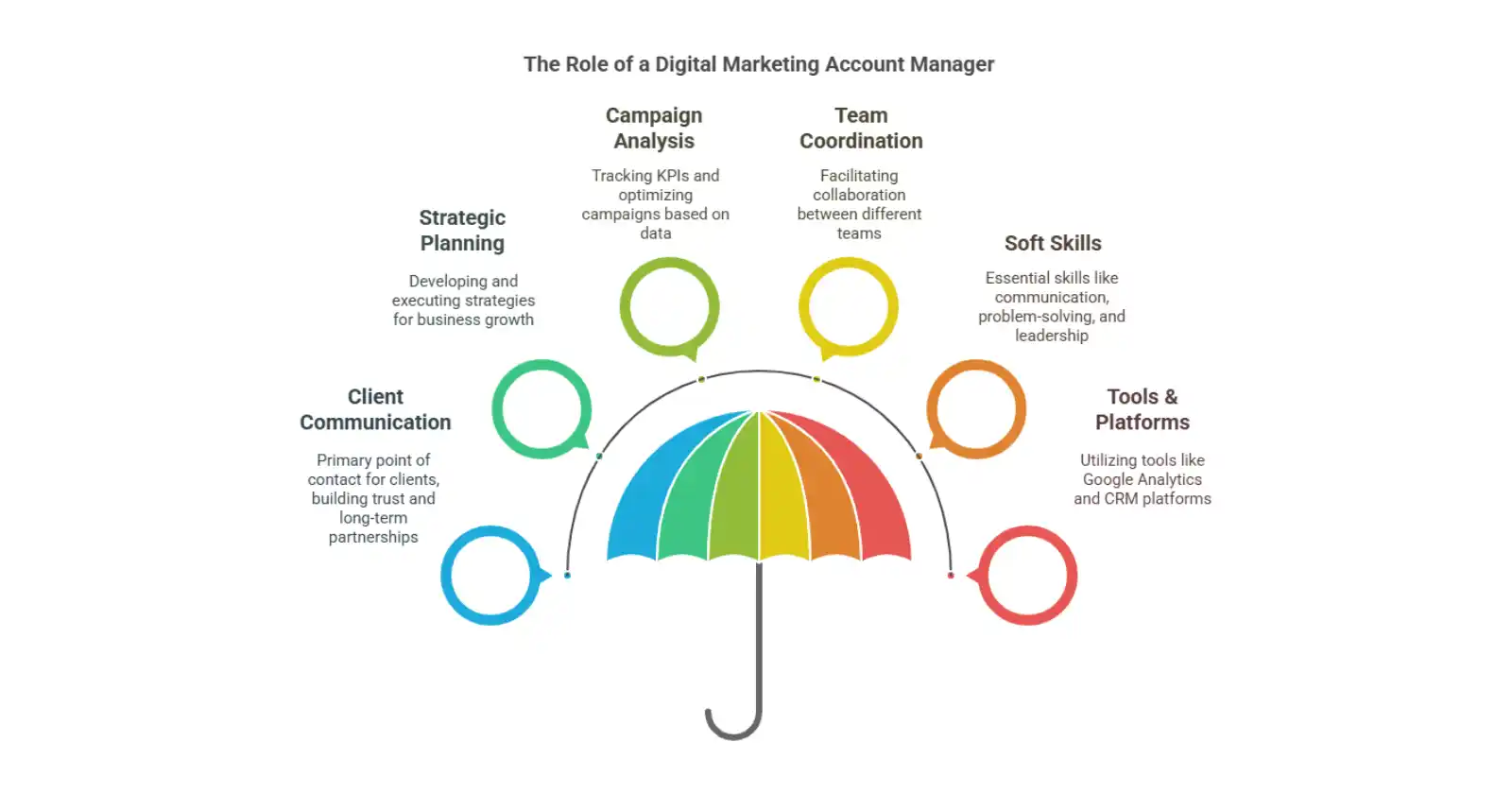Struggling to get real results from B2B SEO? Learn how to create a winning B2B SEO campaign to bring leads, authority and dominate your niche step-by-step.
What is B2B SEO?
B2B SEO (Business-to-Business Search Engine Optimization) is the practice of optimizing a website to attract and convert decision-makers from other businesses via organic search. Unlike B2C (Business-to-Consumer), B2B SEO focuses on longer sales cycles, multiple stakeholders and high-value transactions.
Differences Between B2B and B2C SEO
| Factor | B2B SEO | B2C SEO |
| Buyer Journey | Long, multi-stage | Shorter, emotionally driven |
| Decision-makers | Multiple stakeholders (CMOs, CTOs, etc.) | Individual consumers |
| Content Type | In-depth, data-driven, expertise-based | Short-form, visual, emotionally persuasive |
| SEO Focus | Authority, precision, intent alignment | Visibility, volume, brand recall |
| Keyword Strategy | Low-volume, high-intent | High-volume, short-tail |

Why Traditional Tactics Don’t Work in B2B Markets
Traditional SEO often fails in B2B because it doesn’t map semantic relationships between topics, entities and user intent. You must organize your niche semantically to win in the long run. You first focus on,
- Volume-first approaches.
- Keyword stuffing.
- Ignoring buyer personas.
- Link building for DA alone.
Understanding Search Intent in B2B SEO
Navigational vs Informational vs Transactional Queries
- Navigational: “HubSpot login” – Brand-related, low opportunity.
- Informational: “What is enterprise CRM?” – Top of funnel.
- Transactional: “Best CRM for law firms” – Bottom of funnel.
Mapping Intent to Funnel Stages
| Intent Type | Funnel Stage | Content Format |
| Informational | TOFU (Awareness) | Blog posts, guides, glossaries |
| Navigational | MOFU (Consideration) | Product comparisons, case studies |
| Transactional | BOFU (Decision) | Demo pages, whitepapers, pricing |
Predictive Information Retrieval in B2B
Google increasingly uses Predictive Information Retrieval (PIR) to serve content based on user journey patterns.
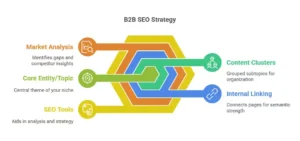
Topical Authority in B2B Campaigns
Importance of Topical Maps
It organizes all relevant subtopics, questions, entities and search intents related to your niche. Sends strong entity signals to Google.
Example: For a B2B cyber security SaaS. Parent topic: “Cybersecurity for Enterprises”. Clusters: “Data compliance,” “Phishing prevention,” “Zero Trust architecture”
How to Cluster Content for Authority?
Use semantic relationships to group your content:
- Entity-focused clusters: e.g. “GDPR compliance,” “HIPAA security”
- Intent-focused clusters: e.g. “How-to guides,” “Solution comparisons”
- Stage-focused clusters: e.g. “Top 10 guides” → “Tool comparisons” → “Case studies”
Internal Linking Strategies for Semantic Strength
Google reads link context, not just anchor text. Link from high-authority to lower-authority pages. Add contextual snippets before or after links.
Building Your Winning B2B SEO Strategy
Market and Competitor Analysis
Identify topical gaps your competitors miss. Study content depth and entity coverage in your niche. Use tools like MarketMuse, Ahrefs or TopicalMap.
Creating a Topical Map for Your Niche
Define your core entity/topic. Break it into clusters based on buyer stages. Fill each cluster with pages targeting long-tail, informational and transactional queries. Use Google’s NLP, People Also Ask and related searches.
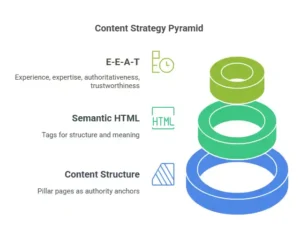
Content Creation & Optimization
Structuring Pillar Pages and Supporting Articles
Pillar pages act as authority anchors. Each should cover a broad topic thoroughly, and then link supporting articles to the subtopics.
Pillar Example: “Enterprise Data Security”
Supporting Articles
- “What is Zero Trust Security?”
- “How to Prevent Insider Threats”
- “Top 10 Data Security Tools for Enterprises”
Using Semantic HTML and Rich Entities
Google processes structure and meaning, not just words.
Use semantic HTML tags: <article>, <section>, <aside>, <header>, <main>, <footer>. Mark key terms as entities in context, e.g. “ISO 27001”. Use tools like InLinks, OnPage.ai or Schema App.
Expert Quotes and Data for E-E-A-T
E-E-A-T (Experience, Expertise, Authoritativeness, Trustworthiness) is critical in B2B. Reference sources, statistics and case studies. Highlight author bios, credentials and experience. Add author schema and citation schema to amplify trust signals.
Technical SEO Considerations
Site Architecture for B2B SEO
Be flat but semantically structured. Group content by clusters and buyer journey. Crawlers can follow internal links easily. Example:
/cybersecurity/ → /cybersecurity/zero-trust/ → /cybersecurity/zero-trust-vs-vpn/
Schema Markup and Entity-Based Optimization
Use structured data to make content machine-readable and entity-enriched. Add Article, Organization, Person, FAQ and Product schema. Use Entity IDs (e.g. Wikidata links).
Core Web Vitals and Crawl Efficiency
Fast load times, stable layout (CLS) and interactivity (FID/INP). Fix crawl traps and reduce parameterized URLs. Submit XML sitemaps by topical cluster for better crawl.
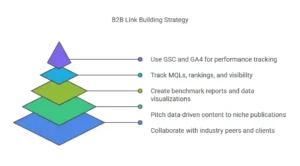
Link Building in B2B
Relationship-Based Link Earning
This is the most sustainable strategy in B2B. Collaborate with industry peers, vendors and clients.
Guest Posting in Niche B2B Publications
Choose industry-relevant sites with topical alignment not just high DA. Pitch data-driven content. Link to deep content, not homepages. Use the guest post for your entity topicality.
Creating Linkable Assets for Professionals
Linkable assets should also link internally to boost the semantic authority of key URLs. What works best?
- Benchmark reports
- Whitepapers
- Data visualizations
Measuring Success & Continuous Improvement
B2B SEO KPIs: MQLs, Rankings, Visibility
MQLs (Marketing Qualified Leads). Organic-assisted conversions. Visibility across full topical clusters.
Using GSC and Analytics
Use Google Search Console to know rising queries & featured snippet opportunities. Track page-level performance by topic using Google Analytics 4 (GA4). Map performance to content clusters for better ROI reporting.
Common Mistakes in B2B SEO Campaigns
Ignoring Long-Tail Opportunities
Most high-converting B2B queries are, Low-volume, Highly specific & Long-tail.
Fix: Use entity-based keyword research to identify underserved questions.
Not Aligning Content with Buyer Stages
Many B2B sites dump all content in a blog with no funnel structure.
Fix: Use internal links to push users down.
Underutilizing Semantic Tools and Data
Many ignore tools that:
- Surface entities
- Analyze semantic structure
- Reveal gaps in topical coverage
Fix: Use tools like Surfer SEO, InLinks, Clearscope or TopicalMap.
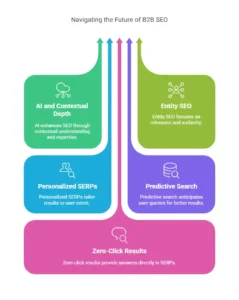
Future of B2B SEO
AI, Entity SEO and Personalized SERPs
Content will be ranked based on contextual depth and expertise, not just backlinks.
Predictive Search and the Rise of Zero-Click Results
Google is targeting to predict the next question and answer it within the SERP. Optimize for Featured Snippets, People Also Ask, and Knowledge Panels. Use schema + semantic structuring.
Conclusion
Use topical maps, semantic optimization and strategic content framework to bring long-term success and lead generation.

